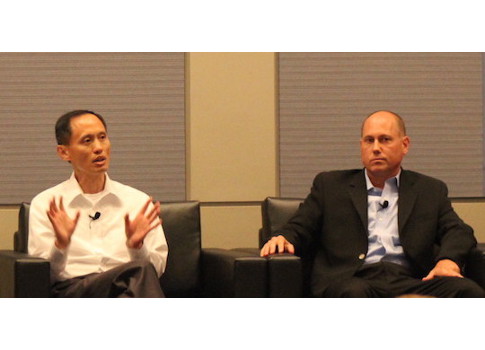Speakers at the 2016 Global Automation and Manufacturing Summit (GAMS) event at IMTS 2016 discussed the Industrial Internet of Things (IIoT) from a variety of perspectives, which are highlighted.

Changing the mindset in manufacturing is the first step toward transforming industry into a connected, data-driven and highly productive enterprise. That was one of the most common conclusions voiced by speakers at the 2016 Global Automation and Manufacturing Summit (GAMS), part of the Industrial Automation North America (IANA) pavilion at the 2016 IMTS Show in Chicago in September.
The half-day event was presented by CFE Media in conjunction with Hannover Fairs USA and featured speakers from all aspects of industry, consultancy and associations interested in the growth of the Industrial Internet of Things (IIoT). An overflow crowd at Chicago’s McCormick Place heard speakers extol the value of IIoT and the need for manufacturers to change to meet the changing technology.
"I think what we all need to do is step back and look at what you’ve been doing and look to change things," said Jack Nehlig, president of Phoenix Contact USA and the keynote speaker at the 2016 GAMS event. "Have some young people criticize what you’re doing and think about what you could do. Institutional memory is a problem. I don’t think we know what we don’t know. Once we get that mindset fixed, then things will get a lot easier."
With the image of a human and robotic hand on the screen, Nehlig said the image portrays two of the keys to IIoT’s successful adoption. "One is intimacy. There’s been a wall from automation, and you’re going to have to get involved in that world," he said. "Two is trust. That’s what a handshake is. Sooner or later you’re going to have to trust these machines."
Who will rule the clouds?
In the first general session, experts looked at the increase in cloud computing and the use of either open-architecture platforms or proprietary platforms such as GE’s Predix.
In either event, manufacturing will need to move toward adoption of IIoT at some point, said Dr. Shi-Wan Lin, co-chair of the architectural task force for the Industrial Internet Consortium (IIC) and chairman and co-founder of Thingswise LLC.
"Plant managers should be in the driver’s seat because they know what is needed," said Lin. "Pick some of those simple problems and apply the idea to the IIoT. Start early with some concrete project that will help optimize plant production. Coordinate your plant operation and increase the intelligence in the operation. This will take years, but everyone’s going to need to start sooner or later."
"We think there’s a whole thing around quality," said Rob McGreevy, vice president of operations, information and asset management for Schneider Electric. "There’s new applications and low-cost sensing. We think it’s actually going to be a collapsing of the levels and a flattening across the board. This will enable a range of solutions with a range of different platforms built around the asset. Everything will be built specifically to create an open system."
Calling Predix a "gated community," Rich Carpenter, product general manager for GE’s automation and controls product platforms, said changing the way manufacturing operates will mean greater speed in operations. "Just about every asset is digitally modeled somewhere," he said. "We want that culture of ‘try, fail fast, and learn.’ Speed is so important. How fast and how well you do something is so critical in today’s environment."
Robotics: The rise of the machines
The second session focused on the increased use of robotics and their integration into manufacturing. It’s a process that Control System Integrator Association (CSIA) CEO Jose Rivera sees happening already, fueled by the use of robots in everyday life. "There’s a cross-pollination from residential to industrial," Rivera said. "You’re going to have robots that will be interfacing with humans in a much deeper way. That will help manufacturing on the plan floor."
Calculating that value for manufacturing will help plant management get buy-in for the project, according to Rick Vanden Boom, automated systems group manager at Applied Manufacturing Technologies. "Companies want to automate, but most often we find opportunities that address harsh environments, ergonomic issues, and the manufacturing environment," he said.
"There’s also the consideration for labor," Vanden Boom added. "Companies have a rough idea of what they’d like to do, but they haven’t [been] through the process. Working through ROI can let engineers take the process forward to management." Michael Lindley, vice president of business development and marketing for Concept Systems, said the changing nature of robotics is tied directly into the growth in computing available everywhere. "Processors have become very powerful and efficient," Lindley said. "Combine that with 3-D and 2-D technologies and you have something very special. With the IIoT, there are a lot of customers asking questions, wondering where (industry is) going with it?"
How maintenance and Big Data can coexist
The final panel focused on one of the most promising areas for manufacturing improvement through IIoT-maintenance. The potential to move from predictive or preventive maintenance to the concept of prescriptive maintenance requires a significant philosophical as well as technological shift.
"The power of analytics and Big Data is that you can analyze trends and patterns," said Sal Spada, a member of the discrete automation team at ARC Advisory Group. Spada shared some of the research data from ARC, including a slide that said current machine utilization in the machine tool industry was less than 45%.
The importance of improved maintenance was tied to better use of data, said Franz Gruber, CEO of Forcam. "Big Data should be purpose-driven," Gruber said. "You always should take things with the end in mind. When possible, you should start with a fresh approach."
"If you look at many companies, maintenance is not the key," Gruber added. Aurelio Banda, CEO and president of Beckhoff USA, had a similar perspective. "IIoT for us is an emerging strategy that allows us to utilize standards and create the ability for capturing data to keep the plant up and running."
"IIoT gives you more information about what you should already know," said Chris LeBeau, global director of IT at Advanced Technology Services, Inc. (ATS). He said the key questions to ask are, "How can do I that better, and will this information allow me to do it better?
"Whatever metrics you use, make sure you use them right," LeBeau added. "Make sure it’s locked down and has a consistent view."
The 2016 Global Automation and Manufacturing Summit was sponsored by Beckhoff, Forcam, Radwell, Advanced Technology Services, Inc. (ATS) and SAP.
Chris Vavra contributed to this report.



